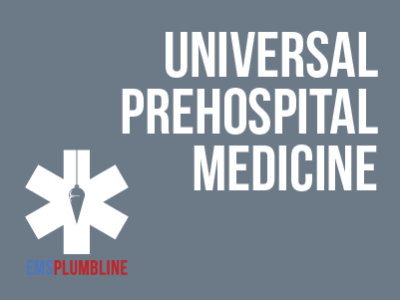 |
Sepsis for Paramedics, Part 3—Conclusions to Consider |
1.00 |
In this final segment, Paramedic Hoskins does an excellent job of closing the discussion. The two medical directors are encouraged to give advice and you will want to hear what they have to say. Final Exam: This multiple choice exam is designed to test your knowledge of the material you just reviewed. You have two attempts to gain an 80% or higher on this exam. Please take your time and answer each question carefully. |
 |
Bedrock: Therapeutic Communications for EMS |
1.00 |
The topic of therapeutic communications relates to nearly every EMS response and is especially important for high-acuity situations. Elizabeth C. Shannon, EMT, MS, RN, PMHNP-BC, brings her years of experience as a mental health care provider and an EMT to the table in this insightful discussion. As you hear her navigate the questions posed, we hope that you will confirm what you are already doing well. We also hope that your reflection on the subject will lead to improved EMS responses for you and the other medics on your crew.
Final Exam: Please read each question carefully. You will have two attempts to gain a 75% or higher on this exam. If you are not successful in two attempts, you are welcome to take the course again to gain the certification. |
 |
Budgeting: Reviewing Budgets |
1.00 |
A typical budget contains information for a single year and is updated and revised periodically. Each company creates a budget that fits its unique needs. A budget can be used for many purposes, but its primary functions should be to support strategic goals and to help identify when actual results deviate from what was predicted. |
 |
Quality Management: The Costs Of Quality |
0.50 |
Before the quality revolution that began in the United States in the 1980s, quality was frequently viewed as a goal that came at a higher price for production. However, the reality is that poor quality is a result of the ineffective use of resources, including wasted material and labor. Therefore, improved quality means better use of resources and lower costs.
In this course you will learn to: identify the relationship between quality and cost, the benefits of establishing quality requirements, management’s responsibilities for achieving conformance, and the costs of customer dissatisfaction. |
 |
Ground Cover Fires |
1.50 |
This course is an introductory level course that introduces the basic concepts of fighting fires that involve natural ground cover. This course describes fire behaviors associated with ground cover fires, identifies the types of equipment as well as methods used to combat these fires. The lesson also identifies specific hazards associated with ground cover fires and describes methods for mitigating the risk of those hazards. |
 |
Guiding School-Age Children in Groups: Supervision and Boundaries |
1.00 |
When large numbers of children are involved in the program, it is challenging to create and deliver school-age program activities that can meet the needs of all children. The key to success is taking a systematic approach to program planning. It is important for staff to understand how to select appropriate activity options and use effective management strategies that make it possible to offer a balanced variety of simultaneous activity options. This understanding will help staff plan and implement a program that effectively supports, nurtures, and guides individual differences and fosters positive interaction among children in groups. |
 |
Ketorolac in Prehospital Medicine |
0.65 |
This module is designed to introduce Ketorolac (Toradol) to providers in the MLREMS region as an optional addition to the formulary. |
 |
Basic Health & Safety Requirements for Certification |
6.00 |
Best practices and standards for health and safety are the foundation of quality child care. Meeting the basic health and safety needs of all children sets the stage for positive child outcomes.
This health and safety orientation module provides an overview of the basic health and safety requirements and best practices in nine of the topic areas outlined in the Child Care and Development Block Grant (CCDBG) Reauthorization of 2015. The topics are as follows:
Safe spaces; Transportation safety; Handling and storage of hazardous materials; Emergency preparedness; Prevention and control of infectious disease; Food and allergic reactions and how to respond; Administration of medication; Shaken baby syndrome/abusive head trauma; Safe sleep and SUIDS prevention.
This course is designed to meet your professional development needs. It can be taken as a stand-alone learning event, or as part of a broader early childhood education curriculum. In addition to state child care regulations, there may be other health and safety measures required by your municipality, township, or county. Check with county or local offices for information on local health and safety requirements. |
 |
GED: Math - Unit 5: Coordinate Plane |
1.00 |
Welcome to Unit 5: Coordinate Plane. If you've ever graphed points, or read a graph, you've worked with the coordinate plane. In this unit, we'll learn about points, the lines that connect them, and the equations used to create them. |
 |
GED: Social Studies - Unit 5: Post-Test |
0.25 |
Welcome to Unit 5: Post-Test. This post-test covers civics and government, US history, economics, and world geography. At the end of this post-test is a table that matches each test question to the content it covers. Use it to review and content you haven't mastered. |











